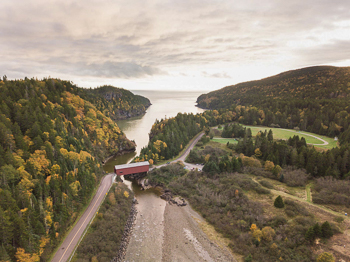
Geology
Fundy National Park
Fundy's hidden story
Covered by the soil and the forests or guarded by inaccessible, tide-washed cliffs, the geology of Fundy National Park is a well-kept secret. There are ways, however, to touch this ancient heart of Fundy. Exploring the beaches of the Bay of Fundy, hiking along the deep river valleys and even travelling over the Caledonia Highlands, you can piece together the story which is as rich and varied as that of the Earth itself.
The Bay of Fundy Coast
While exploring the beaches and learning about the amazing Fundy tides, let your eyes wander back to the land. You will find steep cliffs which are being sculpted by the daily movements of Fundy's giant tides. In fact, the water has exposed the bedrock of the planet for most of the coastline of the park. This rock has a story to tell.
Around Alma and Herring Cove the story is one of rivers and jungles. The grey and beige rocks forming the impressive cliffs of Owl's Head are made of sandstone. This rock used to be sand and mud which a vast and ancient river lay down during the Carboniferous era (about 325 million years ago). Along this river there was a lush, tropical jungle. You can read this incredible story if you take a walk along the beach near the town of Alma. The rock has a fine sandy look to it and contains many black plant fossils and thin seams of coal.
Point Wolfe

The story is considerably older at Point Wolfe where volcanoes and the movement of the continents have formed the oldest rocks in the park. Walk down the steps to Point Wolfe beach and as soon as you reach the beach you will notice some grey, green rocks forming a low cliff along the right side of this inlet. The rock has been smoothed by the tides but the story can still be deciphered. Volcanoes erupting ash and lava created offshore islands during the pre-Cambrian era (one billion years ago). Afterwards, during a collision between the continents of Europe and North America, these volcanic islands were bulldozed into the mainland. Look for the white quartz veins, swirling folds and criss-crossing fractures in the rock, which tell of this transformation. Rocks, which have undergone changes due to the heat and pressure of continental collisions, are called metamorphic rocks.
Point Wolfe is a geologist's paradise. Opposite the grey rocks, you will notice rusty, maroon-colored cliffs towering above you. The rusty-red cliffs tell a tale of crumbling mountains. These mountains were created by the ancient pre-Cambrian volcanoes and by the collision of Europe and North America. At one time they rivaled the Rockies in massive splendor. But they were worn down, or eroded, by the passage of time. Water and gravity piled all of the debris at their feet. These boulders and pebbles were later cemented together to form a new rock which we call the Hopewell conglomerate. If the name Hopewell sounds familiar to you, you are probably thinking of the Rocks Provincial Park at Hopewell, where the conglomerate is also found. You can also find it at Herring Cove. Don't forget to examine all of the rounded rocks and pebbles that have been cemented together to form this conglomerate. At one time they were the backbone of towering mountains.
- Date modified :